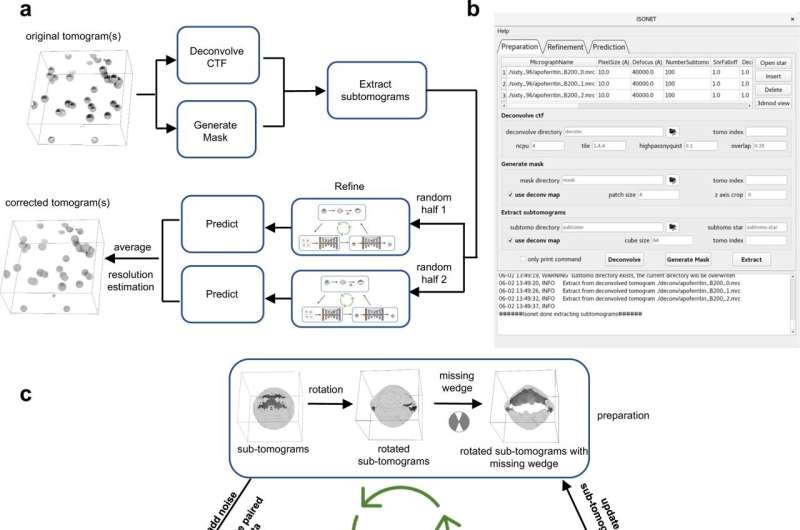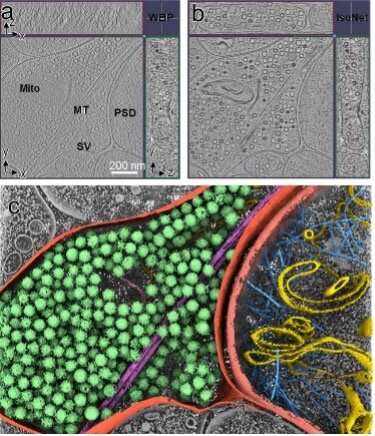Principle and workflow of IsoNet. a Workflow of the IsoNet software. b GUI of IsoNet. c Illustration of Refine step: First, subtomograms are rotated and then applied with additional missing-wedge artifacts along other directions (e.g., YZ axis) to produce paired data for training. Second, the paired data is used to train a neural network with U-net architecture. Third, the trained neural network is applied to the extracted subtomograms to produce missing-wedge corrected subtomograms. The recovered information in these subtomograms is added to the original subtomograms, producing new datasets for the next iteration. d, e Validation of IsoNet with simulated subtomogram of apoferritin (d) and ribosome (e). Surface views from three orthogonal directions of the reconstructions are shown after increasing iterations of IsoNet processing. Blue arrows indicate segments of RNA duplexes. Credit: Nature Communications (2022). DOI: 10.1038/s41467-022-33957-8
In a study published in Nature Communication, a team led by Prof. Bi Guoqiang from the University of Science and Technology of China (USTC) and Shenzhen Institute of Advanced Technology, Chinese Academy of Sciences (CAS), together with collaborators from the United States, developed a software package named IsoNet for the isotropic reconstruction in cryogenic electron tomography (cryoET). Their work effectively solved the intrinsic "missing-wedge" problem and low signal-to-noise ratio problems in cryoET.
Anisotropic resolution caused by the intrinsic "missing-wedge" problem has long been a challenge when using CryoET for the visualization of cellular structures. To solve this, the team developed IsoNet, a software package based on iterative self-supervised deep learning artificial neural network.
Using the rotated cryoET tomographic 3D reconstruction data as the training set, their algorithm is able to perform missing-edge correction on the cryoET data. Simultaneously, a denoising process is added to the IsoNet, allowing the artificial neural network to recover missing information and denoise tomographic 3D data simultaneously.
By performing IsoNet reconstructions on simulated sub-tomograms of apoferritin and ribosome, the team obtained results comparable to low-resolution atomic models. Reconstructions were also done for the tomographic 3D data of the immature HIV capsid, the paraflagellar rod and the neuronal synapse of cultured cells, all of which gave impressive results.
It is noteworthy that after using the IsoNet to reconstruct the tomogram of the neuronal synapse, which typically contains a large number of proteins, membranous organelles, cytoskeleton and other complex structures, the tomographic 3D information of the vesicles, mitochondria, microtubules, microfilaments, cell membranes and protein complexes were all well recovered.
Reconstruction data of the synapse cryoET before and after processed by IsoNet, and the 3D visualization rendering of the ultrastructure in the synapses after processed by IsoNet. Credit: Prof. Bi's team
After its release, IsoNet has raised lots of discussions, an important one of which is how IsoNet implements missing-wedge correction. A major deduction is that the neural network can learn the features of biological structures like proteins at different angles in 3D space during training, and supplement this information to the missing-wedge direction, similar to the 3D averaging of single-particle cryo-electron microscopy.
Therefore, by continuously optimizing the neural network structure and expanding the training set, IsoNet will be able to recover high-resolution 3D structure information of each protein molecule in the cell, consequently laying a solid foundation for the visualization of the high-resolution 3D structure and distribution of each protein molecule in situ.
According to experts Dimitry Tegunov and others experts, the concept of IsoNet would be the future development direction of cryoET.
More information: Yun-Tao Liu et al, Isotropic reconstruction for electron tomography with deep learning, Nature Communications (2022). DOI: 10.1038/s41467-022-33957-8
Journal information: Nature Communications
Provided by University of Science and Technology of China

























